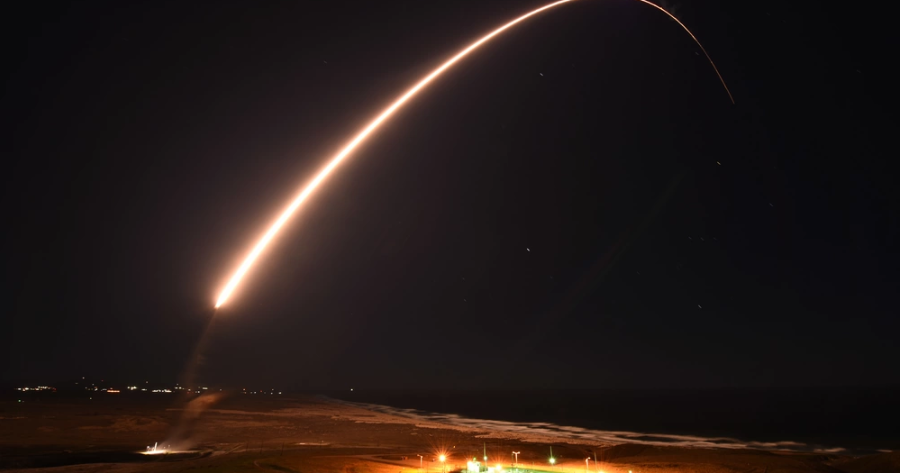Nuclear Tensions: A Wake-Up Call at Vandenberg Space Force Base
In the quiet nights of northern Santa Barbara County, the peace is often shattered by the thunderous roar of intercontinental ballistic missile (ICBM) test launches from Vandenberg Space Force Base. These events, usually occurring after dark, serve as a stark reminder of the ever-looming threat of nuclear warfare. For many residents, the sound of these launches becomes a sort of unfortunate alarm, echoing the fragility of human existence in a world where nuclear threats persist.
The Test Launches and Their Implications
On any given night, when a missile is launched from Vandenberg, it embarks on a journey over 4,200 miles to the Kwajalein Atoll in the Marshall Islands. These test launches symbolize not just military might but an unsettling reality: the balance of power hinges precariously on the existence of nuclear arsenals. Observers often find themselves grappling with the distressing thought that such acts are not merely exercises but potent signs of the times—an indication that global stability is constantly hanging by a thread.
Political Posturing and Nuclear Strategy
A key moment that reflects the current state of affairs was President Trump’s address to nearly 800 military leaders at Marine Base Quantico in Virginia. While his speech contained elements of humor, it also veered into unsettling territory as he chose to boast about nuclear capabilities. He spoke candidly about deploying Trident submarines along the Russian coast, highlighting the lethal nature of these weapons and affirming America’s superiority in submarine technology. Such rhetoric invites a troubling perspective: is this bravado a sign of strength or a perilous game of chicken on the global stage?
The Russian Response: A Mirror Image
Not long after, Russia’s own display of military capability during a test launch reflects the broader geopolitical tension. President Vladimir Putin’s demonstration was a calculated reminder of Russia’s nuclear capabilities amid the ongoing conflict with Ukraine. This tit-for-tat showcasing of military might raises an alarming question: Are the leaders of these nuclear-armed nations acting irrationally, or is this simply the way of power in an increasingly complex international landscape?
Shared Mentality: The U.S. and Russia
The nuclear doctrines of both the U.S. and Russia reveal a shocking level of similarity. Both countries maintain a triad of nuclear weapon systems, composed of land-based ICBMs, nuclear-armed bombers, and submarines. These arsenals grant both nations the ability to annihilate humanity multiple times over. It’s an unsettling thought, yet one that captures the essence of modern deterrence theory—an unstable balance that relies on mutual fear of destruction.
Command Authority: A Double-Edged Sword
In both nations, the power to launch nuclear weapons rests in the hands of a single individual. President Trump, like Putin, possesses the authority to authorize a nuclear strike without the need for consensus. This concentration of power raises significant ethical questions. In a tense climate, the decisions taken by these leaders have far-reaching implications, potentially affecting millions of lives in an instant.
The Problem of Deterrence
U.S. and Russian leaders often justify their nuclear arsenals as tools of deterrence, arguing that possessing such weapons prevents wars. However, this rationale is fraught with complications. Both nations have similar preemptive strike policies that suggest a first-strike option is permissible, even in the face of conventional threats. In doing so, they perpetuate a cycle of fear and vulnerability; once a nuclear strike occurs, the logic of deterrence collapses.
The Moral Dilemma of Launch Protocols
The ethical implications of nuclear command protocols cannot be overstated. Military personnel tasked with managing these arsenals face a moral quandary. If they are aware of an impending attack against the U.S., do they launch a counterstrike, knowing it could lead to catastrophic loss of life? A missile officer might be forced to grapple with the knowledge that their actions would not be merely defensive but could result in killing millions of innocent people.
The United Nations’ Perspective
The international community, particularly the United Nations, recognizes the urgent need for disarmament. The 2017 Treaty on the Prohibition of Nuclear Weapons (TPNW) became a radical approach toward nuclear disarmament, advocating for a world free of such weapons. Although the treaty has gained traction, with 99 nations signing on, it reflects an unfortunate reality: no nuclear power has embraced its principles.
The Need for Change
In light of the nuclear arms race and the rhetoric from both superpowers, a question lingers: should the United States lead the charge toward disarmament? The TPNW emphasizes a moral imperative for nations to reject the notion of deterrence. As the only nation to have used nuclear weapons, the U.S. bears a unique responsibility to reconsider its position in the global arena, advocating for a world devoid of nuclear threats.
In light of these pressing issues, it becomes paramount to engage in meaningful discussions around the implications of our current nuclear strategies. It is essential to question whether maintaining such arsenals truly contributes to global security or merely perpetuates a cycle of fear and hostility.



